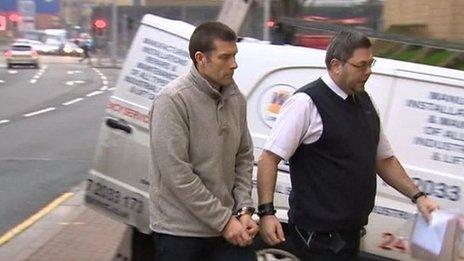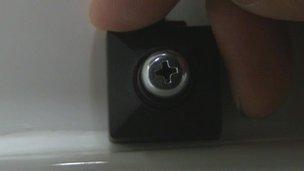How a digital Peeping Tom was caught
- Published

Gareth Williams' name came up during an investigation by Toronto Police
When Toronto Police in Canada arrested a city resident on suspicion of selling child sex abuse images and films, it created a ripple felt three years later and some 3,000 miles away in south Wales - uncovering a shocking hidden crime.
Behind a clock face, a fan and a toilet light switch, three tiny camera lenses smaller than a shirt button were secretly capturing intimate images of children.
The cameras were so tiny and well-disguised that they were unlikely to ever be spotted, even by a close observer.
And the man responsible for the cameras - well respected and popular Cardiff teacher Gareth Williams.
On Monday, at Newport Crown Court, 47-year-old Williams admitted nine charges of voyeurism, 20 of making indecent photos and two of possessing indecent photos.
He also admitted possessing 679 indecent moving images of children of a voyeuristic nature. He will be sentenced next month.
But how had police uncovered this act of snooping, which initially led to him pleading guilty to three counts of voyeurism?
And could the crime have been prevented if the UK authorities had acted on information they were given sooner?
'Graphic images'

Williams appearing at a previous court hearing
Suspicions were only raised about Williams in 2012 after officers in Canada filtered through credit card records from people who had bought sexually explicit images of children from a website run by the man they had been investigating.
The Toronto Police inquiry had begun two years earlier when undercover officers made contact with a man who was sharing "very graphic images" of young children being sexually abused.
The man was operating a child exploitation movie production and distribution company called Azov Films which had customers all around the world.
After a seven-month investigation called Project Spade, Brian Way, 42, of Toronto was charged in May 2011 under 11 separate categories relating to the possession, making, distribution and import and export of child sex abuse images and the proceeds of crime.
Officers from Toronto's Child Exploitation Co-ordination Centre and the Royal Canadian Mounted Police then sent intelligence on people who had used his website to law enforcement agencies in more than 50 countries.
Among that intelligence were Williams's details.
Gareth Williams presenting a Welsh-language children's programme from 1993
He had sought out sexually explicit images of children online, and paid for them using his credit card.
That information was passed to the UK's Child Exploitation and Online Protection Centre (Ceop) in April 2012.
But it took another 21 months before Williams, a seemingly respectable and trustworthy man who had in his younger years been a Welsh language television children's presenter, was arrested.
Finally in November 2013, the National Crime Agency, which now oversees Ceop, confirmed that 2,345 UK suspects were passed onto local police forces - including information about Williams.
Computer seized

The cameras used by Williams can be disguised as screws among other things
Officers from South Wales Police arrested him on 23 January, seizing his computer to examine its contents.
Along with more than 4,500 indecent images of children, including some depicting sexual acts performed by adults on children, they found recordings of children going to the toilet, which they quickly realised had been filmed by Williams in identifiable houses.
He was arrested and charged with three counts of voyeurism by filming children going to the toilet in a house, which he admitted.
After further inquiries, Williams was charged with additional counts of voyeurism and making and possessing indecent images which he admitted on Monday.
Ceop said it was carrying an independent review of how quickly it acted on the intelligence, and admit that all steps which should have been completed at the time, did not take place.
A Home Office spokesperson said: "Child sexual exploitation is an abhorrent crime which this government is determined to stamp out.
"By bringing Ceop within the National Crime Agency we ensured it has more resources and more specialist support to draw on, such as the National Cyber Crime Unit.
"The NCA's UK and global reach is extensive, with officers stationed in over 40 countries working to stop the abuse of children.
"We have also worked with industry to develop tough controls so that child abuse images are removed from the internet where possible.
"But there is still more to do, so we've set up the UK-US taskforce, to counter online child exploitation, and we are drawing on the brightest and best minds in industry to stop the internet being used to abuse children."
So far 341 people have been arrested worldwide as a result of the Toronto Police investigation while 386 children who were being directly abused or exploited by customers of the website have been rescued.

Project Spade has so far identified criminals in over 50 countries